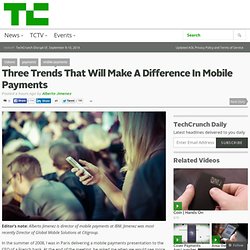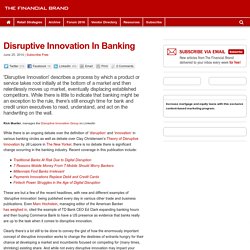

The Financial Brand: Marketing Insights for Banks & Credit Unions - Next Gen PFM: A Great Contextual Mobile Banking Offer. There may be no other area of digital banking that has provided more promise, caused more confusion or undergone more transformation than personal financial management (PFM).

With several strong players globally, it is interesting to see the innovations that have occurred with this solution over the past 12 months. By Jim Marous, Editor, Retail Banking Strategies No solution in financial services generates more discrepancy between what a consumer says they want and what they are willing to put effort towards than the management of money. A part of every consumer’s New Year’s resolutions, the desire to budget, save, invest and spend more wisely has always been easier said than done. “PFM vendors and banks will only succeed if the focus moves to creating context-sensitive insight and functionality that helps consumers make good financial decisions.” — Frank Bria, Principal and CEO, Bria Analytics Group ( Read More: Consumers Are Ready For PFM Whenever Their Banks And Credit Unions Are) The Mobile Transformation. Three Trends That Will Make A Difference In Mobile Payments.
Editor’s note: Alberto Jimenez is director of mobile payments at IBM.

Jimenez was most recently Director of Global Mobile Solutions at Citigroup. In the summer of 2008, I was in Paris delivering a mobile payments presentation to the CEO of a French bank. At the end of the meeting, he asked me when we would see more than 50 percent of retail payments transactions in developed markets go through mobile. With unbending confidence, I responded that within the next five years the majority of consumer transactions in developed markets would originate from mobile devices. I was wrong. Those with a history in the mobile payments industry know that it has been a slow (and mostly disappointing) journey.
Over the years, formidable companies have failed in this space. When debating the future of mobile payments, there’s a fairly common argument that “it is not about payments, it’s about commerce.” 1. 2. 3. IMAGE BY Shutterstock USER mekCar (IMAGE HAS BEEN MODIFIED) New Digital Currency Aims to Unite Every Money System on Earth. Getty Rodrigo Batista is the CEO of Mercado Bitcoin, the first Brazilian bitcoin exchange and one of the largest digital currency operations in Latin America.

Today, Mercado lets you swap Brazilian real for both bitcoin and litecoin, another currency that exists only on the internet, but Batista will soon expand the scope of his operation. By the end of August, he says, his site will embrace a brand new digital currency project called Stellar. Unveiled last week by a not-for-profit foundation bootstrapped by one of the most important developers in the world of digital currency, Jed McCaleb, and one of the hottest startups in the rapidly evolving realm of online payments, Stripe, this new project aims to bring digital currencies to a much wider audience and provide a much smoother way of moving all sorts of money over the internet.
That’s why Batista is so quickly moving his Mercado exchange to this new technology. The digital battle that banks must win. One in three people in developed markets now carries a smartphone, and few doubt that banks will rely increasingly on digital channels to serve the fast-growing population of consumers who rely on multiple devices to conduct daily business online.

In the United States, where smartphones account for more than half of mobile subscriptions, one-third of consumers are using their phones to make payments. Unfortunately for banks, many of these payments are transacted through mobile apps controlled by online-payments specialists and digital merchants. Banking startup Simple seems to be struggling to sign up active users. The Value of Customer Experience, Quantified - Peter Kriss. By Peter Kriss | 10:00 AM August 1, 2014 Intuitively, most people recognize the value of a great customer experience.

Brands that deliver them are ones that we want to interact with as customers — that we become loyal to, and that we recommend to our friends and family. But as executives leading businesses, the value of delivering such an experience is often a lot less clear, because it can be hard to quantify. Rationales for focusing on customer experience tend to be driven by a gut belief that it’s just “the right thing to do.” The problem with this is that often, whether experience is a priority or not simply becomes a battle of opinions. It was for this reason that we wanted to explore ways of quantifying the impact of good versus poor customer experiences — and then see what the value was in delivering them.
The Recession Generation: How Millennials Are Changing Money Management Forever. Mobile Banking Rises Across the Globe. More than 1.75 billion mobile phone users will have used their devices for banking purposes by the end of 2019, compared to 800 million this year, according to a report from Juniper Research.

Emerging countries such as China, India and Bangladesh also witnessed significant growth in the past 12 months, the study found. The report also noted that nearly 100 percent of the banks analyzed had some sort of mobile (SMS, browser and app based) and online banking offering, with almost every bank having apps available for at least one smartphone operating system.
Banking apps are ranked highly among the most downloaded financial apps in different app stores, with banks reporting high number of average logins per month per user. 15 Top Tablet Banking Apps. 7 Ways to Navigate Digital Disruption in Banking. Disruptive Innovation In Banking. 'Disruptive Innovation' describes a process by which a product or service takes root initially at the bottom of a market and then relentlessly moves up market, eventually displacing established competitors.

While there is little to indicate that banking might be an exception to the rule, there’s still enough time for bank and credit union executives to read, understand, and act on the handwriting on the wall. Rick Mueller, manages the Disruptive Innovation Group on LinkedIn While there is an ongoing debate over the definition of ‘disruption‘ and ‘innovation‘ in various banking circles as well as debate over Clay Christensen’s Theory of Disruptive Innovation by Jill Lepore in The New Yorker, there is no debate there is significant change occurring in the banking industry.
Recent coverage in this publication include: